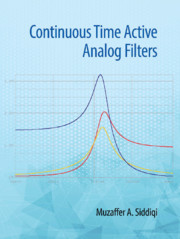Book contents
- Frontmatter
- Dedication
- Contents
- Preface
- Acknowledgments
- 1 Analog Filter: Concepts
- 2 First-and Second-order Filters
- 3 Magnitude Approximations
- 4 Delay: Approximation and Optimization
- 5 Frequency and Impedance Transformations
- 6 Sensitivity of Active Networks
- 7 Single Amplifier Second-order Filters
- 8 Multi Amplifier Second-order Filter Sections
- 9 Direct Form Synthesis: Element Substitution and Operational Simulation
- 10 Cascade Approach: Optimization and Tuning
- 11 Amplification and Filtering in Biomedical Applications
- 12 Audio Signal Processing and Anti-aliasing Filters
- 13 Follow the Leader Feedback Filters
- 14 Switched Capacitor Circuits
- 15 Operational Transconductance Amplifier-C Filters
- 16 Current Conveyors and CDTA (Current Differencing Transconductance Amplifiers) Based Filters
- 17 Active R and Active C Filters
- Index
- References
15 - Operational Transconductance Amplifier-C Filters
Published online by Cambridge University Press: 24 December 2019
- Frontmatter
- Dedication
- Contents
- Preface
- Acknowledgments
- 1 Analog Filter: Concepts
- 2 First-and Second-order Filters
- 3 Magnitude Approximations
- 4 Delay: Approximation and Optimization
- 5 Frequency and Impedance Transformations
- 6 Sensitivity of Active Networks
- 7 Single Amplifier Second-order Filters
- 8 Multi Amplifier Second-order Filter Sections
- 9 Direct Form Synthesis: Element Substitution and Operational Simulation
- 10 Cascade Approach: Optimization and Tuning
- 11 Amplification and Filtering in Biomedical Applications
- 12 Audio Signal Processing and Anti-aliasing Filters
- 13 Follow the Leader Feedback Filters
- 14 Switched Capacitor Circuits
- 15 Operational Transconductance Amplifier-C Filters
- 16 Current Conveyors and CDTA (Current Differencing Transconductance Amplifiers) Based Filters
- 17 Active R and Active C Filters
- Index
- References
Summary
Introduction
Operational transconductance amplifiers (OTAs) have emerged as a powerful alternative to OAs because of their current mode (CM) nature. Their CM nature allows OTAs to be used for much higher frequencies. Another major advantage of using OTAs is the electronic control it has over trans-conductance, which allows much easier tuning of filter parameters. The fact that only OTAs and capacitors are needed also makes the filter attractive for monolithic integrated circuit fabrication.
Since the development of OA-RC filter design is well established and extensively studied, it has been used to advantage while using OTAs. Filter design using OTAs follow a similar pattern and design procedures used in OA-RC synthesis; however, they are tailored to specific needs as will be shown in this chapter.
A brief review of the basic building blocks using OTAs is provided in Section 15.2. Simulation of grounded and floating resistors, inverting and non-inverting integrators, addition of voltages (and currents) and voltage amplifiers, for their stand-alone use or their application for realizing filter sections is included. First-order LPFs (low pass filter) and HPF (high pass filter) design is shown in Section 15.3 using integrators. Because of the suitability of OTA based circuits for differential outputs, the filter circuits discussed in Section 15.3 are then converted to differential mode. Similar to OA-RC synthesis, second-order filters are realized using the two-integrator loop method. Higher-order filters are realized using the element substitution method through the simulation of inductances and capacitances in Section 15.6 and 15.7. Filter realization using operational simulation is also discussed in Section 15.8.
Basic Building Blocks Using OTAs
OAs have been used for inverting and non-inverting amplification, summation (subtraction), integration and differentiation. In addition, while designing filters, OAs have been extensively used for simulating inductors and FDNRs (frequency dependant negative resistors). OTAs have also been used for all such entities; in addition, they are used for simulating grounded resistances (GRs) and floating resistances (FRs) as well. Hence, the resulting OTA-C circuits are not only realizable, but preferred as it makes them easily integratable in the monolithic form with more precise filter parameters.
- Type
- Chapter
- Information
- Continuous Time Active Analog Filters , pp. 453 - 492Publisher: Cambridge University PressPrint publication year: 2020



